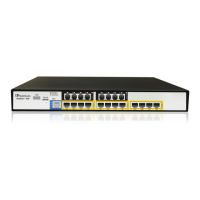1 Overview
The Mediant 800 Multi-Service Business Router (MSBR) is a networking device that
combines multiple service functions such as a Media Gateway, Session Border Controller
(SBC), Data Router and Firewall, LAN switch, WAN access, Stand Alone Survivability
(SAS) and an integrated general-purpose server. The device offers enhanced dialing plans
and voice routing capabilities along with SIP-to-SIP mediation, allowing enterprises to
implement SIP Trunking services (IP-to-IP call routing) and IP-based Unified
Communications, as well as flexible PSTN and legacy PBX connectivity.
The device is designed as a secured Voice-over-IP (VoIP) and data platform. Enhanced
media gateway security features include, for example, SRTP for media, TLS for SIP
control, and IPSec for management. Data security functions include integrated Stateful
Firewall, IDS/IPS, SSL for remote user access, and site-to-site VPN. A fully featured
enterprise class SBC provides a secured voice network deployment based on a Back-to-
Back User Agent (B2BUA) implementation.
The device also offers call "survivability" solutions using its Stand Alone Survivability (SAS)
or Cloud Resilience Package applications, ensuring service continuity to enterprises served
by a centralized SIP-based IP-Centrex server or branch offices of distributed enterprises.
Call survivability enables internal office communication between SIP clients in the case of
disconnection from the centralized SIP IP-Centrex server or IP-PBX.
The device provides Foreign Exchange Station (FXS) and/or Foreign Exchange Office
(FXO) telephony module interfaces, depending on ordered hardware configuration. The
device supports either a combination of FXS and FXO port interfaces, or only FXS or only
FXO interfaces. The device can support up to 12 simultaneous VoIP calls. Each FXS or
FXO module provides four analog RJ-11 ports. The FXO module can be used to connect
analog lines of an enterprise's PBX or the PSTN, to the IP network. The FXS module can
be used to connect legacy telephones, fax machines, and modems to the IP network.
Optionally, the FXS module can be connected to the external trunk lines of a PBX. When
deployed with a combination of FXO and FXS modules, the device can be used as a PBX
for Small Office Home Office (SOHO) users, and businesses not equipped with a PBX. The
FXS modules also support the Analog Lifeline feature, enabling an FXS port to connect
directly to the PSTN upon power and/or network failure.
The device supports up to 8 ISDN Basic Rate Interface (BRI) S/T interfaces (RJ-45 ports),
supporting up to 16 voice channels. These connect ISDN terminal equipment such as
ISDN telephones. The device also provides an optional, single E1/T1 interface port,
supporting Transparent, CAS and ISDN protocols. The device supports various ISDN PRI
protocols such as Euro ISDN, North American NI2, Lucent™ 4/5ESS, Nortel™ DMS-100
and others. It also supports various ISDN BRI protocols such as ETSI 5ESS and QSIG
over BRI. It also supports different variants of CAS protocols for E1 and T1 spans,
including MFC R2, E&M immediate start, E&M delay dial / start, loop start and ground start.
The device's data routing capabilities support static and dynamic routing protocols such as
RIP/OSPF and BGP, Virtual Routing and Forwarding (VRF-Lite) where interfaces can be
clustered into a VRF to provide segregated routing domains. The device supports various
optional WAN interfaces, providing flexibility in connecting to Service Providers:

